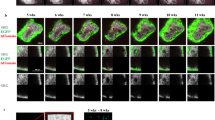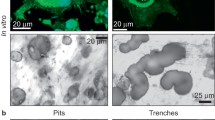Summary
Little is known about the relationship between the age of the skeleton and the development of multinucleated bone-resorbing cells, osteoclasts. It has been shown that mineralized bone implanted onto the chick chorioallantoic membrane (CAM) is effective in the recruitment and differentiation of osteoclast precursors. In studies reported here we used the CAM system to examine the influence of bone matrix age on osteoclast formation. Devitalized mineralized bone particles (75–250 μm) were prepared from rats of various ages (2, 4, 9, 12, and 16 months). The particles were implanted onto the chick chorioallantoic membrane and 8 days later implants were harvested and processed for morphometric or immunohistochemical analysis. Osteoclast number, cell area, nucleocytoplasmic ratio, and the presence of a distinctive osteoclast antigen, defined by the 121F monoclonal antibody, were determined. Bone particles of each age group resulted in the formation of osteoclast-like giant cells. Compared with multinucleated cells that formed in response to bone particles obtained from 2-month-old rats, matrix from the oldest age group (16 months) elicited significantly fewer and smaller cells which contained a smaller number of nuclei. These data suggest that with aging, bone undergoes qualitative and/or quantitative changes that affect the recruitment and differentiation of osteoclast precursor cells.
Similar content being viewed by others
References
Krukowski M, Kahn AJ (1982) Inductive specificity of mineralized bone matrix in ectopic osteoclast differentiation. Calcif Tissue Int 34:474–479
Chambers TJ (1981) Phagocytic recognition of bone by macrophages. J Pathology 135:1–7
Webber D, Osdoby P, Hauschka P, Krukowski M (1990) Correlation of an osteoclast antigen and ruffled border on giant cells formed in response to resorbable substrates. J Bone Min Res 5:401–410
Urist MR, Silverman BF, Buring K, Dubuc CL, Rosenberg JM (1967) The bone induction principle. Clin Orthop 53:243–283
Glowacki J, Altobelli D, Mulliken JB (1981) Fate of mineralized and demineralized osseous implants in cranial defects. Calcif Tissue Int 33:71–76
Chambers TJ, Thomson BM, Fuller K (1984) Effect of substrate composition on bone resorption by rabbit osteoclasts. J Cell Sci 70:61–71
Malone JD, Teitelbaum SL, Griffin GL, Senior RM, Kahn AJ (1982) Recruitment of osteoclast precursors by purified bone matrix constituents. J Cell Biol 92:227–230
Sweet MBE, Thonar EJ-MA, Marsh J (1979) Age-related changes in proteoglycan structure. Arch Biochem Biophys 198:439–448
Vancikova O, Deyl Z (1973) Aging of connective tissue. Solubilization of collagen from animals varying in age and species by reagents capable of splitting aldimine bonds. Exp Gerontol 8:297–306
Mbuyi-Muamba JM, Dequeker J (1983) Age and sex variations of bone matrix proteins in Wistar rats. Growth 47:301–315
Dickson JR, Bagga MK (1985) Changes with age in the noncollagenous proteins of human bone. Connect Tissue Res 14:77–85
Syftestad GT, Urist MR (1982) Bone aging. Clin Orthop Rel Res 162:288–297
Vogel HG (1979) Influence of maturation and aging on mechanical and biochemical parameters of rat bone. Gerontology 25:16–23
Oursler MJ, Bell LV, Clevinger B, Osdoby P (1985) Identification of osteoclast-specific monoclonal antibodies. J Cell Biol 100:1592–1600
McLean IW, Nakane PK (1974) Periodate-lysine-paraformaldehyde fixative: a new fixative for immunoelectron microscopy. J Histochem Cytochem 22:1077–1083
Glowacki J, Lian JB (1987) Impaired recruitment and differentiation of osteoclast progenitors by osteocalcin-deplete bone implants. Cell Differ Dev 21:247–254
Glowacki J, Cox KA (1986) Osteoclastic features of cells that resorb bone implants in rats. Calcif Tissue Int 39:97–103
Bak B, Andreassen TT (1989) The effect of aging on fracture healing in the rat. Calcif Tissue Int 45:292–297
Ekeland A, Engesaeter LB, Langeland N (1982) Influence of age on mechanical properties of healing fractures and intact bones in rats. Acta Orthop Scand 53:527–534
Tonna EA, Cronkite EP (1962) Changes in the skeletal cell proliferative response to trauma concomitant with aging. J Bone Joint Surg 44-A:1557–1568
Centrella M, Canalis E (1985) Transforming and nontransforming growth factors are present in medium conditioned by fetal rat calvariae. Proc Natl Acad Sci 82:7335–7339
Seyedin SM, Thompson AY, Bentz H, Rosen DM, McPherson JM, Conti A, Siegel NR, Galluppi GR, Piez KA (1986) Cartilage-inducing Factor-A. Apparent identity to transforming growth factor-B. J Biol Chem 261:5693–5695
Kiebzak GM, Smith R, Gundberg CC, Howe JC, Sacktor B (1988) Bone status of senescent male rats: chemical, morphometric, and mechanical analysis. J Bone Min Res 3(1):37–45
Vanderschueren D, Grevers G, Raymaeker G, Devos P, Dequeker J (1990) Sex and age-related changes in bone and serum osteocalcin. Calcif Tissue Int 46:179–182
Author information
Authors and Affiliations
Rights and permissions
About this article
Cite this article
Groessner-Schreiber, B., Krukowski, M., Hertweck, D. et al. Osteoclast formation is related to bone matrix age. Calcif Tissue Int 48, 335–340 (1991). https://doi.org/10.1007/BF02556153
Received:
Revised:
Issue Date:
DOI: https://doi.org/10.1007/BF02556153




